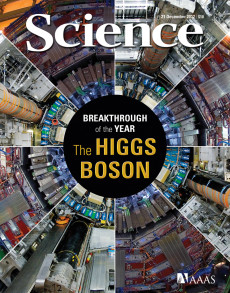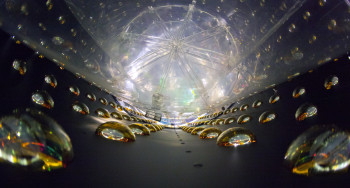NERSC Contributes to Science Magazine's Breakthroughs of the Year
January 14, 2013
By Linda Vu
Contact: cscomms@lbl.gov
Every year, Science magazine editors and staff sift through numerous scientific accomplishments and ultimately crown one “Breakthrough of the Year.” Of the top 10 finalists for 2012, Lawrence Berkeley National Laboratory (Berkeley Lab) computational researchers were major contributors to two accomplishments, including the winner: Discovery of the Higgs Boson.
Two Department of Energy facilities managed by Berkeley Lab—the National Energy Research Scientific Computing Center (NERSC) and the Energy Sciences Network (ESnet)—also provided critical support that made these breakthroughs possible.
Discovery of the Higgs Boson:
Breakthrough of the Year
On July 4, 2012, researchers at the European Organization for Nuclear Research (CERN) announced that they had spotted a particle that could be the elusive Higgs boson—the last missing piece of the Standard Model of fundamental particles and forces. Physicists believe that the Higgs, hypothesized 40 years ago, could explain how all fundamental particles get their mass.
To produce the Higgs, CERN built the Large Hadron Collider (LHC)—a 27-kilometer-long particle accelerator beneath the Franco-Swiss border. To see the Higgs, researchers relied on two LHC detectors—ATLAS and CMS. And to sift out new physics from the torrent of ATLAS detector data, scientists depend Athena—a software framework developed under the leadership ofPaolo Calafiura, a staff scientist in the Berkeley Lab’s Software Systems Group.
According to Calafiura, ATLAS detectors record about 400 collision events per second and Athena allows thousands of globally dispersed researchers to collaborate result in real-time.
Two facilities located at Berkeley Lab also contribute critical resources to the ATLAS analysis process. NERSC's PDSF is one of the biggest Tier-3 ATLAS computing facilities in the U.S., while ESnet transports all of this data between Tier-1 sites at the National Laboratories, and collaborators at universities, research facilities, and national labs across the country.
»More about Berkeley Lab's Involvement with ATLAS.
»Science Breakthrough of the Year.
Neutrino Mixing Angle: Runner Up
Born in the hearts of stars and other nuclear reactions, neutrinos pass mostly unhindered through everything from planets to people. Although they come in three basic “flavors”—electron, muon and tau—neutrinos and their corresponding antineutrinos can transform from one flavor to another while traveling near light-speed. How they do this has been a long-standing mystery.
In 2012, the Daya Bay Reactor Neutrino Experiment in China measured the last parameter describing how these elusive particles morph into one another. This finding opens the door for a new understanding of fundamental physics and may explain why there is far more ordinary matter than antimatter in the cosmos.
Craig Tull, who heads Berkeley Lab’s Science Software Systems Group, led the Daya Bay Neutrino experiment’s overall computing effort. His responsibilities included overseeing development of the NuWA software framework, which allows globally dispersed researchers to collaborate data analysis work; and the Spade-driven data management and processing pipeline. He also worked with ESnet and NERSC staff to ensure that Daya Bay data could be processed, analyzed and archived in real time, providing scientists immediate insight to the quality of physics data and performance of detectors.
“Thanks to the computing expertise at Berkeley Lab, we were able to see antineutrinos with NuWa in the first filled detectors within 24 hours,” said Tull in an announcement shortly after the discovery was announced. “We were able to see an anti-neutrino deficit in the far hall within days. And finally, we have been able to extract a high-quality θ13 value within only 75 days of start of far-hall running.”
As a Tier-1 facility for the Daya Bay Experiment, NERSC's is the only site where all of the raw, simulated and derived data are analyzed and archived in the US. From NERSC, ESnet carries Daya Bay data to Brookhaven National Laboratory (BNL), which serves as a Tier-2 US facility for the experiment. BNL is responsible for secondary data processing, as well as some archiving. The network also transports Daya Bay data to collaborators at universities, research institutions and national laboratories across the US.
In addition to Tull, other Berkeley Lab Computing Sciences staff to contribute to the Daya Bay Experiment’s software, computing and networking infrastructure includes Simon Patton and Jason Lee.
»More about Berkeley Lab Computing Sciences Contributions to Daya Bay.
»Science Runner-Up for Breakthrough of the Year.
About NERSC and Berkeley Lab
The National Energy Research Scientific Computing Center (NERSC) is a U.S. Department of Energy Office of Science User Facility that serves as the primary high performance computing center for scientific research sponsored by the Office of Science. Located at Lawrence Berkeley National Laboratory, NERSC serves almost 10,000 scientists at national laboratories and universities researching a wide range of problems in climate, fusion energy, materials science, physics, chemistry, computational biology, and other disciplines. Berkeley Lab is a DOE national laboratory located in Berkeley, California. It conducts unclassified scientific research and is managed by the University of California for the U.S. Department of Energy. »Learn more about computing sciences at Berkeley Lab.









